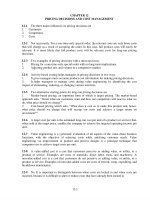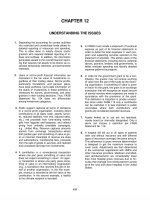Accounting26th ch 12
Bạn đang xem bản rút gọn của tài liệu. Xem và tải ngay bản đầy đủ của tài liệu tại đây (222 KB, 29 trang )
CHAPTER
Accounting for
Partnerships and Limited
Liability Companies
Warren
Reeve
Duchac
©2016
human/iStock/360/Getty Images
Accounting
26e
Proprietorships, Partnerships, and
Limited Liability Companies
• The four most common legal forms for organizing and
operating a business are as follows:
o
o
o
o
Proprietorship
Corporation
Partnership
Limited liability company
©2016
Proprietorships
(slide 1 of 2)
• A proprietorship is a company owned by a single
•
individual.
The most common proprietorships are professional
service providers, such as lawyers, architects, realtors,
and physicians.
©2016
Proprietorships
(slide 2 of 2)
•
Characteristics of proprietorships include the following:
o
Simple to form
There are no legal restrictions or forms to file.
o
No limitation on legal liability
The owner is personally liable for any debts or legal claims against the
business.
o
Not taxable
For federal income tax purposes, a proprietorship is not taxed. Instead, the
proprietorship’s income or loss is “passed through” to the owner’s individual
income tax return.
o
Limited life
When the owner dies or retires, the proprietorship ceases to exist.
o
Limited ability to raise capital (funds)
The ability to raise capital (funds) is limited to what the owner can provide
from personal resources or through borrowing.
©2016
Partnerships
(slide 1 of 2)
• A partnership is an association of two or more
•
persons who own and manage a business for profit.
Partnerships are less widely used than proprietorships.
©2016
Partnerships
(slide 2 of 2)
•
Characteristics of a partnership include the following:
o
Moderately complex to form
A partnership is often formed with a partnership agreement.
– A partnership agreement includes matters such as amounts to be invested, limits on
withdrawals, distributions of income and losses, and admission and withdrawal of partners.
o
No limitation on legal liability
The partners are personally liable for any debts or legal claims against the
partnership.
o
Not taxable
For federal income tax purposes, a partnership is not taxed. Instead, the
proprietorship’s income or loss is “passed through” to the partners’ individual income
tax returns.
o
Limited life
When the owner dies or retires, the partnership ceases to exist.
o
Limited ability to raise capital (funds)
The ability to raise capital (funds) for the partnership is limited to what the partners
can provide from personal resources or through borrowing.
©2016
Limited Liability Companies
(slide 1 of 2)
• A limited liability company (LLC) is a form of legal
•
entity that provides limited liability to its owners but is
treated as a partnership for tax purposes.
The LLC organizational form is popular for small
businesses.
©2016
Limited Liability Companies
(slide 2 of 2)
•
Characteristics of an LLC include the following:
o
Moderately complex to form
An LLC requires an agreement among the owners, who are called members.
– The operating agreement includes matters such as amounts to be invested, limits on
withdrawals, distributions of income and losses, and admission and withdrawal of partners.
o
Limited legal liability
Only the members’ investments in the company are subject to claims of creditors.
o
Not taxable
An LLC may elect to be treated as a partnership for tax purposes. Thus, income
passes through the LLC and is taxed on the individual members’ tax returns.
o
Unlimited life
Most LLC operating agreements specify continuity of life for the LLC, even when a
member withdraws or new members join the LLC.
o
Moderate ability to raise capital (funds)
Because of their limited liability, LLCs are attractive to many investors, thus allowing
for greater access to capital (funds) than is normally the case in a partnership.
©2016
Forming a Partnership
• In forming a partnership, the investments of each
•
•
•
partner are recorded in separate entries.
The assets contributed by a partner are debited to
the partnership asset accounts.
If any liabilities are assumed by the partnership, the
partnership liability accounts are credited.
The partner’s capital account is credited for the net
amount.
©2016
Dividing Income
• Income or losses of the partnership are divided as
specified in the partnership agreement.
o
If there is no specification or agreement, income and losses
are divided equally.
• Common methods of dividing partnership income are
based on:
o
o
Services of the partners
Services and investments of the partners
©2016
Dividing Income: Services of Partners
• One method of dividing partnership income is based
•
on the services provided by each partner to the
partnership.
These services are often recognized by partner salary
allowances.
o
Such allowances reflect differences in partners’ abilities and
time devoted to the partnership. Such allowances are
recorded as divisions of net income and are credited to the
partners’ capital accounts.
• A closing entry is used to record the division of net
income, even if the partners do not withdraw the
amounts of their salary allowances.
©2016
Dividing Income:
Services of Partners and Investments
• A partnership agreement may divide income based
•
upon interest on capital balances of each partner. In
this way, partners with more invested in the
partnership are rewarded by receiving more of the
partnership income.
One such method of dividing partnership income
would be as follows:
1.
2.
3.
Partner salary allowances
Interest on capital investments
Any remaining income equally
©2016
Allowances Exceed Net Income
• In some cases, the net income may be less than the
total of the allowances. In this case, the remaining net
income to divide is a negative amount. This negative
amount is divided among the partners as though it
were a net loss.
©2016
Admitting a Partner
(slide 1 of 2)
• A person may be admitted to a partnership by either
of the following:
o
o
Purchasing an interest from one or more of the existing
partners
Contributing assets to the partnership
©2016
Admitting a Partner
(slide 2 of 2)
•
•
When a new partner is admitted by purchasing an interest from
one or more of the existing partners, the total assets and the
total owners’ equity of the partnership are not affected. The
capital (equity) of the new partner is recorded by transferring
capital (equity) from the existing partners.
When a new partner is admitted by contributing assets to the
partnership, the total assets and the total owners’ equity of the
partnership are increased. The capital (equity) of the new
partner is recorded as the amount of assets contributed to the
partnership by the new partner.
©2016
Admitting a Partner:
Purchasing an Interest from Existing Partners
• When a new partner is admitted by purchasing an
•
interest from one or more of the existing partners, the
transaction is between the new and existing partners
acting as individuals.
The admission of the new partner is recorded by
transferring owners’ equity amounts from the capital
accounts of the selling partners to the capital account
of the new partner.
©2016
Admitting a Partner:
Contributing Assets to a Partnership
• When a new partner is admitted by contributing
assets to the partnership, the total assets and the total
owners’ equity of the partnership are increased.
o
This is because the transaction is between the new partner
and the partnership.
©2016
Revaluation of Assets
• Before a new partner is admitted, the balances of a
partnership’s asset accounts should be stated at
current values. If necessary, the accounts should be
adjusted.
o
o
Any net adjustment (increase or decrease) in asset values is
divided among the capital accounts of the existing partners,
similar to the division of income.
Failure to adjust the partnership accounts for current values
before admission of a new partner may result in the new
partner sharing in asset gains or losses that arose in prior
periods.
©2016
Partner Bonuses
• Partner bonuses may occur in one of two ways:
1.
2.
A new partner may pay existing partners a bonus to join a
partnership.
Existing partners may pay a new partner a bonus to join
the partnership.
• Existing partners receive a bonus when the ownership
•
interest received by the new partner is less than the
amount paid.
In contrast, the new partner receives a bonus when the
ownership interest received by the new partner is
greater than the amount paid.
©2016
Withdrawal of a Partner
(slide 1 of 2)
•
A partner may retire or withdraw from a partnership. In such
cases, the withdrawing partner’s interest is normally sold to the:
o
o
•
Existing partners or
Partnership
If the existing partners purchase the withdrawing partner’s
interest, the purchase and sale of the partnership interest is
between the partners as individuals.
o
The only entry on the partnership’s records is to debit the capital
account of the partner withdrawing and to credit the capital account of
the partner buying the additional interest.
©2016
Withdrawal of a Partner
(slide 2 of 2)
•
•
If the partnership purchases the withdrawing partner’s interest,
the assets and the owners’ equity of the partnership are
reduced by the purchase price.
The entry to record the purchase debits the capital account of
the withdrawing partner and credits Cash for the amount of the
purchase.
o
If not enough partnership cash is available to pay the withdrawing
partner, a liability may be created (credited) for the amount owed the
withdrawing partner.
©2016
Death of a Partner
(slide 1 of 2)
• When a partner dies, the partnership accounts should
•
•
be closed as of the date of death.
The net income for the current period should then be
determined and divided among the partners’ capital
accounts.
The asset accounts should also be adjusted to current
values and the amount of any adjustment divided
among the capital accounts of the partners.
©2016
Death of a Partner
(slide 2 of 2)
• After the income is divided and any assets revalued,
an entry is recorded to close the deceased partner’s
capital account. The entry debits the deceased
partner’s capital account for its balance and credits a
liability account, which is payable to the deceased’s
estate.
©2016
Liquidating Partnerships
(slide 1 of 2)
• When a partnership goes out of business, it sells the
•
assets, pays the creditors, and distributes the
remaining cash or other assets to the partners. This
winding-up process is called the liquidation of the
partnership.
When the partnership goes out of business and the
normal operations are discontinued, the accounts
should be adjusted and closed.
o
The only accounts remaining open will be the asset, contra
asset, liability, and owners’ equity accounts.
©2016
Liquidating Partnerships
(slide 2 of 2)
• The steps in the liquidation process are as follows:
o
o
o
o
Step 1. Sell the partnership assets. This step is called
realization.
Step 2. Distribute any gains or losses from realization to the
partners based on their income-sharing ratio.
Step 3. Pay the claims of creditors, using the cash from the
step 1 realization.
Step 4. Distribute the remaining cash to the partners based
on the balances in their capital accounts.
©2016









